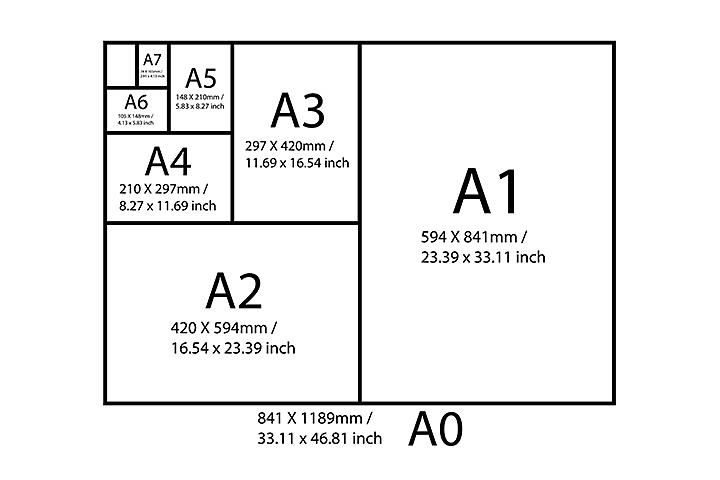A1 Paper Size Guide.
Size A1 paper is the second largest paper format in the A series, defined by the international standard ISO 216 in 1975.
To give you an idea of its scale, A1 paper has a surface area of 0.5 m² or 5,000 cm². That equates to 5.38 ft² or 775 in².
Professionals frequently use A1 paper because of its large size, but it can also be very popular among arts and crafts hobbyists at home. The spacious dimensions of A1 paper make it ideal for posters, photography, painting and other aspects of art and design.
Find out how A1 paper dimensions compare to other formats below.

Size of the different paper formats of the A series in mm and inches
A1 paper dimensions.
The size of A1 paper is 594 x 841 mm or 59.4 x 84.1 cm, which is 23.4 x 33.1 inches. It’s normally used for advertising purposes, such as large posters and display banners. It can also be used in professional settings, for flipcharts and architectural drawings.
Compared to other A series formats, a sheet of A1 paper is the same as:
- half an A0 sheet
- two A2 sheets
- four A3 sheets
- eight A4 sheets (and so on…)
- German scientist Georg Christoph Lichtenberg was the first to establish the A series paper dimensions we use today, as far back as 1786.
- In 1922, this was then officially standardised by Dr Walter Porstmann with the DIN standard (DIN 476), which eventually gave rise to the modern ISO 216 standard.
- One of the main benefits of the A series as a whole is its easy-to-understand ratio, which preserves the proportions of the format when it is cut or folded in half.
More specifically, all A formats are based on the principle of height = width x √2.
For example, you can create A1 paper dimensions by halving the height of a piece of A0 paper, using its width as the new A1 height.
As for the size of A1 paper in pixels, the format varies depending on the resolution of your document in PPI (pixels per inch) and DPI (dots per inch).

Representation of a frame in A1 format
Common uses of A1 paper.
The A1 format is popular in creative sectors, particularly in display marketing and advertising. This is because its larger dimensions make it ideal for printing:
- Posters
- Prints
- Signs
Due to its size, A1 paper can be easily seen from a distance, while still being relatively easy to hang up on a wall or install in a board.
Architectural and construction sectors also sometimes use A1 paper as a standard for technical documents, which need to be printed in large formats to maintain readability and proportion.
Printing A1 paper.
- To print A1 paper at a high-quality (and in one piece), you’ll need a specialist large format printer. These professional devices can produce industry-standard prints for photography, commercial printing, marketing and more.
- If that isn’t possible, you can also print an oversized document using a standard desktop or office printer, by splitting the image across various smaller pages — which is a process called tiling.
- Your printer settings will help to determine how many pieces of paper you require to achieve the final product.
- Using high-quality publishing software such as Adobe InDesign can help you design your oversized A1 print ready to produce and assemble with a desktop printer. Export and print high-resolution PDF files and you can create professional-looking posters with ease.